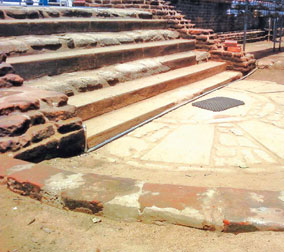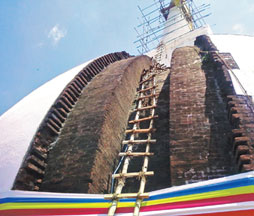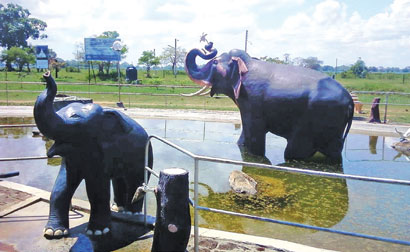Somawathiya Stupa amidst the lush wilderness
By Ganga Ratnayake
 |
|
The Somawathi Stupa |
Once, there was a stupa dazzling like a pearl, completely surrounded
by the lush greenery of the wilderness. Isolated, in an uninhabited
region, the structure could not defy the scorching sun, the torrential
rains, the gushing floods or the invading roots of the green giants for
many years. It couldnít help falling into a state of ruin and slowly
disappearing into oblivion and remaining so for 10 long centuries, in a
dense jungle camouflaged from civilisation.
Upon being restored to its former glory and evolving into a temple
worshipped by thousands of devotees every year, the soaring stupa again
dazzles like a pearl amidst a sea of green. And to pay homage to this
stupa at Somawathiya, the writer and family set off in the wee hours one
day.
Among the relics of the Buddha found in Sri Lanka, two are treated
with utmost respect. They are the Sacred Tooth Relics of the Buddha -
the Left Tooth Relic is enshrined at the Sri Dalada Maligawa in Kandy
while the Right Tooth Relic is enshrined at the Somawathiya also called
Somawathi Raja Maha Vihara in Polonnaruwa. Apart from this fact, the
temple is significant due to its historic and archaeological value and
is also well known as a sacred site where miraculous sightings often
occur.
Dense wilderness
Our route was along the cities of Kandy, Matale, Dambulla, Habarana
and Hingurakgoda. We passed through the Habarana jungle, Minneriya
Sanctuary and Somawathi Strict Natural Reserve before reaching the
Somawathi Raja Maha Vihara. It was like a journey to the heart of mother
nature as the temple was surrounded by breathtaking marshlands and dense
wilderness as far as the eyes could see.
It was a little past 10.40 in the morning when we finally alighted
from the vehicle. The dry warm air and the calling of three eagles
circling high above in the azure sky welcomed us. As we walked past the
towering gateway brimming with enchanting relief motifs and topped with
a big canopy, we were greeted by a stunning spectacle; a beautiful pond
full of tuskers of all sizes, sculpted so deftly that itís hard to tell
them apart from their real counterparts unless you get close to them.
From the spot, we could clearly see the stupa rising above everything
else on flat terrain.
 |
|
The unusual moonstone |
 |
|
The walls of inner
stupas |
 |
|
The Elephant Pond |
The soaring stupa still had scaffolding around its pinnacle as it was
being whitewashed for an upcoming religious event. The tiled courtyard
around the stupa was nothing short of blistering hot, and we could
hardly stand still for a few seconds in one spot. We left the courtyard
and sat under a huge banyan tree. There around us, under the shade of
the great banyan tree, sat dozens of devotees clad in pure white,
reciting stanzas after the Nayaka Thera while attending a Buddha pooja.
Tiled courtyard
Once the event was over, we entered the tiled courtyard once more and
this time headed towards a vahalkada (gateway). Awaiting us was yet
another surprise; within the stupa was a small shrine room built atop a
narrow stairway behind the vahalkada. Right above the offerings table
heaped with flowers in multifarious hues stood a golden casket bearing
the Relics.
Strolling around the premises, I stumbled upon various unusual and
unique features. One was the moonstone beneath a flight of steps which
was missing the usual relief carvings of the four types of animals,
swans and floral patterns found in other moonstones. Flanking the
moonstone were metal racks neatly stacking oil-filled glass jars instead
of the usual clay lamps. Next to one metal rack rose a great banyan tree
snuggling two or three statues of Lord Ganesha around its base.
We went around the sandy courtyard and arrived at the Samadhi Buddha
statue, which resembled the world famous image at Mahamevuna Uyana in
Anuradhapura. Behind this statue stood the Bo tree encircled by a golden
railing. Next to them in a hall were scores of posters and pictures
featuring the mysterious halos and rainbows that have appeared right
around the stupa. Beyond that we came upon an open area dotted with
beautiful iron works holding the usual clay lamps around a Dolos Mahe
Pahana - the lamp that remains lit throughout the year.
Through the oil lamps, we spotted the greenery not too far, reminding
us that we are still surrounded by the Somawathi Strict Natural Reserve
and wildlife sanctuary teeming with wild pachyderms and other animals
big and small. In fact, some of the wild elephants and tuskers love to
throng at the Elephant Pond to quench their thirst early morning or late
evening and some, itís said, even pay homage to the stupa before heading
back to the jungle.
Interior walls
As we went around the stupa, I came upon a portion which revealed its
interior walls, flaunting their sheer breadth. The centre-most wall is
what remains from the very first Somawathi Stupa built by Princess
Somawathi (sister of King Kavantissa) and Prince Giri-Aba in the Second
Century BC. The outer wall portrays the second stupa built by King
Kanitta Tissa in 164 AD, enveloping the original.
It is said in the chronicles that following the cremation of the
Buddha, when the Relics were distributed, King Jayasena - a king of
serpents - brought the Sacred Right Tooth Relic to the Kingdom of Nagas
(serpents). During the construction of Somawathi Stupa, upon the request
of Prince Giri-Aba, a bhikkhu named Mahinda Thera visited the Kingdom of
Nagas and retrieved the Relics to be deposited within the stupa. After
years of being secluded within a dense jungle, the area was cleared and
the stupa renovated in 1947 by Sirimalwatte Sri Piyarathana Thera who
also became the first Chief Priest of the Somawathiya.
En route, we came across many interesting sights such as the free
roaming cattle across watery marshlands, paddy fields and the sparsely
built dry zone homes adjoined by dome-shaped rainwater collectors.
Despite the sizzling heat, which often made us scamper for shady
spots, we enjoyed complete peace of mind and serenity until it was time
for us to leave, having received blessings from this sacred site
snuggled amidst a thriving wilderness.
|


